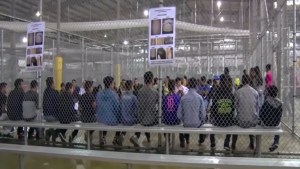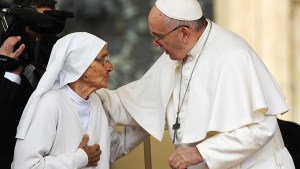An estimated 50% of foreign-born Catholic priests and other “religious workers” in the United States might be forced to go back to their home countries in the coming year, due to a recent change in immigration procedures, according to the United States Conference of Catholic Bishops (USCCB). But the bishops’ conference is hoping for an executive action on the part of the Biden Administration to help resolve the problem.
A recent change of interpretation of immigration regulations has substantially increased the time it takes for priests and others who work for a religious organization to obtain permanent residency.
Local Catholics are already seeing the effects. St. Leo the Great in Ava, Missouri, for example, lost its sole priest in April, leading to a consolidation of the five churches he had been responsible for, with cutbacks on the liturgy schedule.
Fr. Rodelio Ignacio, administrator of Blessed Sacrament Parish in Sandy, Utah, had to return to the Philippines this past spring, because his religious worker visa expired and was not renewed.
The situation has led the Diocese of Paterson, New Jersey, to sue the federal government and a bishop in New York to call for a letter-writing campaign.
David Spicer, assistant director of policy for the United States Conference of Catholic Bishops’ Department of Migration and Refugee Services, said that his office recently conducted a survey to see how the change is affecting dioceses around the country. About 70% of the nation’s dioceses and eparchies responded; 90% of them currently depend on foreign-born religious workers to some extent, Spicer said.
“We asked them to let us know, through the preceding 12 months, whether or not they had any of their religious workers forced to depart, and about 30% of the respondents said that that was the case for them,” he told Aleteia. “And then asking them to look ahead at the next 12 months and predict whether or not they anticipated having any religious workers forced to depart when they would otherwise remain in the United States if they could adjust status, that percentage went up to 50%. So that really cemented for us that this is a growing problem, and it’ll be an increasingly prevalent problem going forward.”
Spicer said that his office has been lobbying both the Administration and Congress to find a solution. He said that since the immigration law is “silent” on how long an applicant needs to stay outside the US between temporary visas, it is possible for the Administration to unilaterally decrease that time.
“We have requested that it be a 30-day timeframe,” he said. “The Administration has been very responsive, and it’s our understanding that they are in the process of shortening the time frame through regulatory action, but the time line for that to occur remains shrouded in uncertainty.”
Congressional action?
On the legislative side, Spicer said, the bishops’ conference has had conversations with several Republican and Democratic members of the House of Representatives and the Senate.
“I’ll say that Senator [Susan] Collins of Maine and Senator [Timothy] Kaine of Virginia, themselves both Catholic, have been incredibly supportive and engaged with us at the USCCB and others on these issues, and they are also working through possible sources of legislative relief,” Spicer said. “It’s a little bit more complicated, because there are certainly more hurdles to get through on the legislative side of things, but they are also working toward possible relief that may fall short of addressing the underlying backlog … but may do something to allow, for example, religious workers to remain in the country beyond that five-year timeframe” while they’re waiting for a slot to apply for a green card.
Erin B. Corcoran, executive director of the Kroc Institute for International Peace Studies and associate teaching professor at the Keough School of Global Affairs at the University of Notre Dame, is an expert on U.S. immigration law and policy, refugee and asylum law, human trafficking and the protection of vulnerable migrant populations.
She explained that religious workers come into the country on an R1 visa. When they want to adjust their immigration status, they do so through a category called EB-4, a miscellaneous category that includes special immigrant juvenile visas, religious worker visas, and some other vulnerable populations visas.
Clash of values
Mary O’Leary, an immigration attorney in Petoskey, Michigan, who represents members of religious orders, explained that beginning in 2013, more and more children from troubled parts of Central America were sent to the United States on their own.
“Many of them qualified for these special immigrant juvenile visas,” O’Leary said.
During the Obama Administration, the State Department decided to remove these special juvenile visas for kids from Guatemala, Honduras, and El Salvador – the so-called Northern Triangle, where widespread poverty, violence, and corruption have prompted many to flee the three nations – from the general pool of EB-4 visas and put them in their own “line” for green cards.
Then, in March-April 2023, the State Department realized it didn’t have the legal authority to pull the Central American juveniles out of the EB-4 line, so they put everybody back in the same pool.
“The way a person’s place in line is established is by something called a priority date, and so when their immigrant petition is filed the day that it reaches the Department of Homeland Security, that establishes your priority date,” O’Leary explained.
A lot of the special immigrant juveniles had been arriving in the United States since 2013-2015, and petitions were being filed for them.
“There’s a large number of them, and so they had been waiting for a longer period of time, especially those from Central America,” O’Leary said. “There were so many of them that they were in the separate line, and so they had earlier priority dates than many of the religious workers, because basically, by about 2022, there had been a relatively long backlog of processing of the petitions for religious workers during that pandemic. They kind of got deprioritized for a while, and then in the spring of 2022 they just went at ‘em and approved everything and basically got everybody up to date again. A lot of people filed their Green Card petitions and started waiting.”
So most of the religious workers that have pending applications have priority dates that are after 2022, much more recent than most of the special immigrant juveniles.
O’Leary recognizes the irony of the situation, as the Catholic Church and other religious organizations do a lot of work with unaccompanied minors.
“They’re doing a lot of the work to support these communities, and this kind of pits these two very compatible or complementary categories — it kind of pits them against each other,” she said. “So it’s competing for visa numbers. It’s just a really awkward situation in that regard.”
She said that in addition to the loss of a priest by a congregation, the snafu also adds a layer of difficulty for religious communities to plan.
In one case she’s been working on, the superior of a small community has to leave the country for a year while awaiting approval. “They’re going to have to bring somebody in to cover for the year,” O’Leary said.
“Our clients are just hoping for the best,” O’Leary said. “They’re praying that it’s all going to work out okay. But, like I say, we don’t know if we’re going to hit the end of the five years, and people are going to have to leave for a year. It’s just sort of a ticking time bomb, and it’s exploding for some people sooner than others.”




